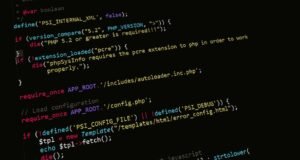Applications Queue in Data Structure
Queues are an essential data structure in computer science that follows the First-In-First-Out (FIFO) principle.
They allow you to store and retrieve elements in the same order they entered the queue. In this article, we will
explore the concept of the queue data structure and its various applications.
Key Takeaways
- Queues are a fundamental data structure in computer science.
- They follow the First-In-First-Out (FIFO) principle.
- Queues are used in a wide range of applications, such as job scheduling and network packet routing.
Understanding Queues
A queue is an abstract data type that represents a collection of elements. It supports two primary operations:
enqueue and dequeue. Elements are added to the back of the queue using the enqueue
operation, and they are removed from the front of the queue using the dequeue operation.
Queues are commonly visualized as a line of people waiting for a service, where the first person to enter the line
is the first to be served. This abstract concept can be applied to various computer science problems, making
queues a valuable tool in algorithm design.
Applications of Queues
Queues find applications in various domains due to their FIFO property and ease of implementation. Let’s explore
some of the key applications of queues:
1. Job Scheduling
In operating systems, queues are extensively used for job scheduling. When multiple processes or tasks are running
concurrently, a queue is used to manage the order in which the tasks are executed. The operating system picks the
next task from the front of the queue and schedules its execution, ensuring fairness and efficient utilization of
resources.
2. Network Packet Routing
In computer networks, queues are utilized for network packet routing. As data packets traverse the network, they
may encounter congestion at various points. Queues enable the buffering of packets in an orderly manner, ensuring
that packets are delivered in the same order they were received. This ensures reliable and efficient communication
between network nodes.
3. Print Spooling
Print spooling systems, found in most operating systems, utilize queues to manage print jobs. When multiple users
send print requests simultaneously, the spooler adds the jobs to a queue. It then processes them one by one,
ensuring fairness and efficient utilization of the printing resources.
Real-World Examples
Queues have numerous real-world examples that demonstrate their practicality. Here are a few:
- Supermarket Checkout: Customers form single-file queues and are served in the order they
arrived. - Call Center: Incoming calls are placed in a queue and handled by agents based on their arrival
order. - Waiting for a Bus: People waiting for a bus form a queue, with the first person who arrived
being the first to board.
Performance Considerations
When implementing a queue, it’s essential to consider performance factors such as enqueue and
dequeue operations, as well as the queue’s size. The choice of data structure to implement a queue
affects these operations. It’s crucial to select a data structure that optimizes these considerations based on the
specific requirements of the application.
An interesting fact about queues is that they can be implemented using arrays or linked lists. *Linked lists offer
dynamic memory allocation, allowing the queue to grow and shrink as needed.
Conclusion
Queues have a wide range of applications in computer science and everyday life. Whether it’s managing tasks in an
operating system or organizing people in a queue, understanding and implementing queues efficiently is vital for
various systems. The First-In-First-Out principle provided by queues enables fair and efficient handling of
resources.

Common Misconceptions
Misconception 1: Applications Queue is the same as a regular queue
One common misconception about the Applications Queue in Data Structure is that it is the same as a regular queue. While both types of queues follow a First-In-First-Out (FIFO) principle, the Applications Queue differentiates itself by providing specific functionalities tailored for different domains.
- The Applications Queue is designed for specific use cases and has specific operations that reflect those uses.
- Unlike a regular queue, the Applications Queue may have additional data associated with each item in the queue.
- The Applications Queue may prioritize certain items based on criteria such as urgency or importance.
Misconception 2: Applications Queue is only used for managing software applications
Another misconception is that the Applications Queue is solely used for managing software applications. While it is true that the Applications Queue can be employed in software development processes, its applications extend beyond just that.
- The Applications Queue can be used in operating systems to manage and schedule processes.
- In telecommunication systems, the Applications Queue can handle call routing and optimization.
- In transportation systems, such as queues in airports or train stations, the Applications Queue can manage passenger flow and boarding processes.
Misconception 3: Applications Queue guarantees real-time processing
Sometimes, people mistakenly believe that using the Applications Queue guarantees real-time processing of tasks. However, this is not the case, as the speed and efficiency of processing depend on various factors.
- The performance of the system or application utilizing the Applications Queue is influenced by the hardware and software resources.
- Other processing bottlenecks in the system, like network or database latency, can impact the overall speed of processing tasks in the queue.
- The complexity of the tasks themselves can affect the processing time, regardless of the queue implementation.
Misconception 4: Applications Queue is the optimal solution for all task management scenarios
Although the Applications Queue is a powerful tool for task management, it is not necessarily the optimal solution in all scenarios. It is crucial to assess the specific requirements and constraints of the task management system before selecting the appropriate data structure.
- In some cases, a priority queue or a stack data structure might be a better fit, depending on the prioritization or ordering requirements.
- For scenarios requiring parallel processing or distributed task management, other data structures like a distributed queue or a message queue may be more suitable.
- The choice of data structure should be based on factors such as the expected workload, scalability, and performance requirements of the task management system.
Misconception 5: Applications Queue is only relevant for large-scale systems
Lastly, a misconception often arises that the Applications Queue is only relevant for large-scale systems. While it is true that large-scale systems commonly implement the Applications Queue, it does not mean that smaller systems or projects cannot benefit from using this data structure.
- Even in small-scale systems, an Applications Queue can help manage asynchronous processes, optimize resource utilization, and improve overall system performance.
- The scalability of the Applications Queue allows it to adapt to the growth of the system without major architecture changes.
- Using the Applications Queue in a small-scale system can provide a foundation for future expansion and accommodate potential system growth.

Introduction
The Applications Queue is a data structure that manages a collection of elements based on the First-In-First-Out (FIFO) principle. This data structure is commonly used in various applications, such as operating systems, task scheduling, network protocols, and more. In this article, we explore different aspects of the Applications Queue and its significance.
Table of Processes
In an operating system, an Applications Queue is often utilized to manage processes. The following table showcases a variety of processes and their corresponding priorities:
| Process | Priority |
|---|---|
| File Compression | High |
| Printing Documents | Medium |
| Virus Scanning | High |
| Backup | Low |
| Video Streaming | Medium |
Network Packet Routing
Another application of an Applications Queue is network packet routing, where packets are placed in a queue and processed accordingly. The following table illustrates the path and arrival time of network packets:
| Packet | Source | Destination | Arrival Time (ms) |
|---|---|---|---|
| 1 | Router A | Router C | 5 |
| 2 | Router B | Router C | 7 |
| 3 | Router A | Router D | 9 |
| 4 | Router C | Router B | 10 |
| 5 | Router D | Router A | 12 |
Incoming Customer Calls
An Applications Queue can also be used to handle incoming customer calls in a call center. The table below displays the caller name and waiting time for the next available representative:
| Caller Name | Waiting Time (minutes) |
|---|---|
| John Smith | 4 |
| Sarah Johnson | 8 |
| Emma Thompson | 2 |
| Michael Davis | 10 |
| Olivia Wilson | 6 |
Tasks Queue
In software development, an Applications Queue can be employed to manage tasks. The following table presents various software development tasks along with their respective status:
| Task | Status |
|---|---|
| Bug Fixing | In Progress |
| Feature Implementation | Not Started |
| Code Review | Completed |
| Documentation | Not Started |
| Testing | In Progress |
Supermarket Checkout
Efficiently managing queues is crucial in supermarket checkout systems. The table below showcases the items and their corresponding checkout times:
| Item | Checkout Time (seconds) |
|---|---|
| Groceries | 120 |
| Toiletries | 60 |
| Clothing | 180 |
| Electronics | 300 |
| Books | 90 |
Buffer Capacity
When dealing with the transfer of data, buffer queues play a vital role. The following table demonstrates the buffer capacity and data size:
| Buffer | Capacity (bytes) | Data Size (bytes) |
|---|---|---|
| A | 500 | 320 |
| B | 200 | 180 |
| C | 1000 | 800 |
| D | 400 | 450 |
| E | 800 | 600 |
Order Processing
An Applications Queue can streamline the order processing system for an e-commerce platform. The table below represents the orders and their statuses:
| Order ID | Status |
|---|---|
| 1234 | Shipped |
| 5678 | In Progress |
| 9012 | Cancelled |
| 3456 | Pending Payment |
| 7890 | Delivered |
Request Queue
A request queue is often utilized in web servers to handle incoming client requests. Here, we present a table depicting the requests and their priorities:
| Request ID | Priority |
|---|---|
| 001 | High |
| 002 | Low |
| 003 | High |
| 004 | Medium |
| 005 | Medium |
Conclusion
The Applications Queue is a versatile data structure that finds applicability in numerous domains, including operating systems, networking, customer service, software development, and e-commerce. By efficiently organizing and managing elements based on their arrival order or priority, the Applications Queue optimizes processes and enhances overall system functionality. Understanding the applications and significance of this data structure is crucial for developers, system administrators, and individuals working with queues.
Applications Queue in Data Structure – Frequently Asked Questions
Q: What is a queue in data structure?
A queue is a linear data structure that follows the First-In-First-Out (FIFO) principle. It consists of two main operations: enqueue, which adds an element to the end of the queue, and dequeue, which removes an element from the front of the queue.
Q: What are the basic operations performed on a queue?
The basic operations performed on a queue are:
- Enqueue: Adds an element to the end of the queue.
- Dequeue: Removes an element from the front of the queue.
- IsEmpty: Checks if the queue is empty.
- IsFull: Checks if the queue is full.
- Peek: Returns the element at the front of the queue without removing it.
Q: What are the applications of a queue?
Queues have various applications in computer science. Some of the common applications include:
- Process Scheduling: Queues are used to manage the order in which processes are executed by a computer system.
- Buffering: Queues are used to store data temporarily when the rate at which data is produced differs from the rate at which it can be processed.
- Job Scheduling: Queues are used to schedule jobs in multiprogramming systems.
- Web Servers: Queues are used to manage incoming requests from clients and prioritize their execution.
Q: How is a queue represented in memory?
A queue can be represented in memory using an array or a linked list. In the array representation, a fixed-size array is used where elements are added at one end and removed from the other end. In the linked list representation, each element of the queue contains a value and a pointer to the next element.
Q: What is the time complexity of queue operations?
The time complexity of queue operations depends on the implementation. In a queue implemented using an array, enqueue and dequeue operations have a time complexity of O(1) when the front and rear are maintained as separate pointers. In a queue implemented using a linked list, enqueue and dequeue operations also have a time complexity of O(1).
Q: Can a queue be implemented using a stack?
Yes, a queue can be implemented using two stacks. This approach is known as the “two-stack” method. One stack is used for enqueue operations, and the other is used for dequeue operations. The elements are transferred between the two stacks to maintain the FIFO order.
Q: What is the difference between a queue and a stack?
The main difference between a queue and a stack is the order in which elements are accessed. In a queue, the element that goes in first is the one that comes out first (FIFO), whereas in a stack, the element that goes in last is the one that comes out first (LIFO).
Q: Can a queue have a negative size or be unbounded?
Yes, a queue can have a negative size or be unbounded depending on the implementation. In some programming languages, the size of the queue is automatically adjusted as elements are added or removed. This allows for flexibility in handling varying amounts of data.
Q: What happens when you try to dequeue an empty queue?
When you try to dequeue an empty queue, an error usually occurs as there is no element to remove. It is important to check if the queue is empty before performing a dequeue operation to avoid such errors.
Q: Are there any other variations of queues?
Yes, there are several variations of queues, including priority queues, circular queues, and double-ended queues (dequeues). Priority queues prioritize elements based on a specific priority, circular queues allow elements to be added and removed from both ends in a circular fashion, and dequeues allow insertion and deletion at both ends.





